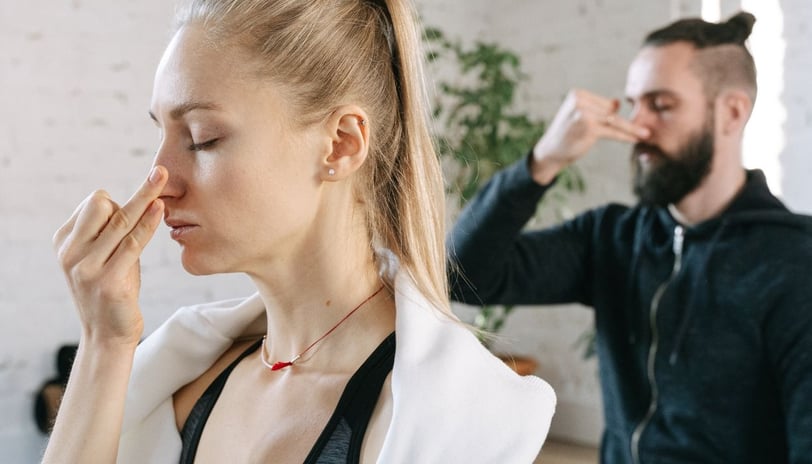Breathwork for Wellness: Techniques to Enhance Vitality and Emotional Resilience
Have you ever noticed how your breath changes when you're stressed or relaxed? Breathing is something we do instinctively, yet it has the power to influence our mental, emotional, and physical well-being. Breathwork, the conscious control of breathing, is an ancient practice gaining popularity for its incredible benefits, from reducing stress to improving lung capacity and boosting emotional resilience. In this article, we’ll explore the science behind breathwork, introduce simple techniques you can practice anywhere, and show how breath control can enhance vitality and help you navigate life’s challenges with greater ease.


The Science of Breathwork
Breathwork works by tapping into the autonomic nervous system (ANS), which regulates involuntary processes like heart rate and digestion. By consciously controlling your breath, you can shift between the sympathetic (fight-or-flight) and parasympathetic (rest-and-digest) states, promoting relaxation, clarity, and balance.
How Breathwork Benefits the Body and Mind
Stress Reduction: Deep breathing lowers cortisol levels, the hormone responsible for stress.
Enhanced Oxygenation: Improves blood flow and energy levels.
Emotional Regulation: Helps manage anxiety, anger, and sadness by calming the nervous system.
Improved Lung Capacity: Strengthens respiratory muscles and increases oxygen efficiency.
Mindfulness and Presence: Creates a meditative state, grounding you in the present moment.


Breathwork Techniques to Try
1. Diaphragmatic (Belly) Breathing
This foundational technique encourages deep breathing from the diaphragm, rather than shallow chest breathing.
How to Practice:
Sit or lie down in a comfortable position.
Place one hand on your chest and the other on your belly.
Inhale deeply through your nose, allowing your belly to rise while keeping your chest still.
Exhale slowly through your mouth, letting your belly fall.
Repeat for 5–10 minutes.
Benefits:
Reduces stress and promotes relaxation.
Improves oxygen intake and lung efficiency.
2. Box Breathing (Square Breathing)
A structured technique often used by Navy SEALs to stay calm under pressure.
How to Practice:
Inhale through your nose for 4 counts.
Hold your breath for 4 counts.
Exhale slowly through your mouth for 4 counts.
Hold your breath for 4 counts.
Repeat for 3–5 minutes.
Benefits:
Increases focus and mental clarity.
Helps regulate emotions and reduce anxiety.
3. Alternate Nostril Breathing (Nadi Shodhana)
An ancient yogic practice that balances energy and calms the mind.
How to Practice:
Sit comfortably with your spine straight.
Close your right nostril with your thumb and inhale deeply through your left nostril.
Close your left nostril with your ring finger, release your thumb, and exhale through your right nostril.
Inhale through your right nostril, close it, and exhale through your left nostril.
Repeat for 5–10 cycles.
Benefits:
Balances the nervous system and enhances focus.
Promotes relaxation and mental clarity.
4. 4-7-8 Breathing
This calming technique helps you fall asleep faster and reduce tension.
How to Practice:
Inhale through your nose for 4 counts.
Hold your breath for 7 counts.
Exhale through your mouth for 8 counts.
Repeat for 4–6 cycles, gradually increasing over time.
Benefits:
Quickly reduces stress and anxiety.
Promotes better sleep.
5. Breath of Fire (Kapalabhati)
A more active technique used in yoga to energize the body and cleanse the lungs.
How to Practice:
Sit comfortably with your spine straight.
Inhale deeply through your nose.
Exhale quickly and forcefully through your nose, pulling your belly in with each exhalation.
Allow the inhalation to happen naturally between exhalations.
Start with 30 seconds and gradually increase to 1–2 minutes.
Benefits:
Boosts energy and mental clarity.
Improves lung capacity and detoxifies the body.
Incorporating Breathwork Into Your Daily Routine
Morning Rituals: Begin your day with energizing breathwork like Breath of Fire to kickstart your metabolism and focus.
Work Breaks: Use Box Breathing or Diaphragmatic Breathing during breaks to reduce stress and refocus.
Before Sleep: Practice 4-7-8 Breathing to wind down and prepare for restful sleep.
Mindful Moments: Incorporate Alternate Nostril Breathing into meditation or yoga sessions.
FAQs About Breathwork
Q: Can anyone practice breathwork?
A: Most people can safely practice breathwork. However, individuals with respiratory issues, heart conditions, or pregnancy should consult a healthcare provider before trying certain techniques.
Q: How long does it take to see results?
A: Benefits like reduced stress can be felt immediately, while improvements in lung capacity and emotional resilience develop over time with consistent practice.
Q: Do I need any special equipment?
A: No equipment is needed—just a quiet space and a few minutes of your time.
The Bigger Picture: Breathwork as a Holistic Wellness Tool
Breathwork is more than just a stress-relief tool; it’s a holistic practice that enhances both physical and emotional well-being. When combined with other wellness habits like regular exercise, healthy nutrition, and mindfulness, breathwork can significantly improve your quality of life.
Conclusion
Breathwork is a simple yet powerful practice that connects us to the present moment while supporting our physical, emotional, and mental health. Whether you’re seeking to reduce stress, boost energy, or cultivate resilience, these techniques can be a transformative addition to your daily routine.
Start with just a few minutes a day—perhaps trying Diaphragmatic Breathing or Box Breathing during a quiet moment. Over time, you’ll notice the profound impact of conscious breathing on your vitality and well-being.
Products Reviews
Disclaimer
The statements on this website have not been evaluated by the Food and Drug Administration. The articles and products advertised are not intended to diagnose, treat, cure, or prevent any disease.
The content of the website and the products advertised are based on the opinions of the authors and are provided solely on an "AS IS" and "AS AVAILABLE" basis. You should do your own research and confirm information with other sources when seeking information about health issues, and always carefully review the information with your healthcare professional before using any of the protocols presented on this website and/or the products indicated. Neither Drops&Pills nor the authors are engaged in rendering medical or similar professional services or advice through this website or the products, and the information provided is not intended to replace medical advice offered by a physician or other licensed healthcare professional. You should not construe the recommendation of the products by Drops&Pills as an endorsement by Drops&Pills of the opinions expressed herein, or any guarantee of any strategy, recommendation, treatment, action, or application of advice made by the authors of the products.
Some names and personally identifiable information on this site have been changed to protect the privacy of individuals.
Drops&Pills is the publisher of the articles on this site. Drops&Pills' role as publisher does not constitute an endorsement, approval or review of the products advertised herein or any claim, statement or opinion used in the promotion of those products.
For product support, please contact the suppliers.
For purchase and order support, please contact the platform you placed the order through.
For support with article information, please contact Drops&Pills here.
*Free shipping according to the rules on the product page.
Natural Products for Better Health
© Drops&Pills Research 2025 All rights reserved
Contacts
contact@dropsandpills.com
